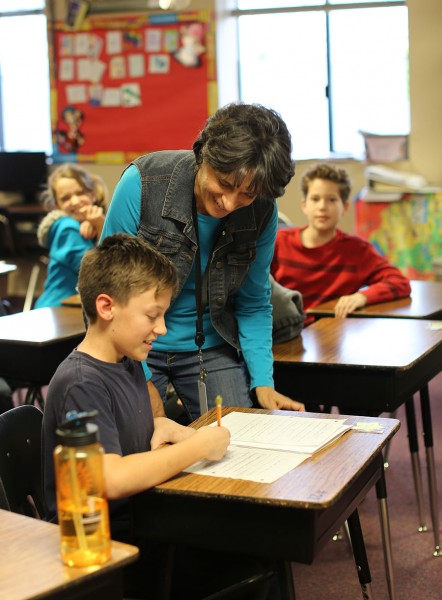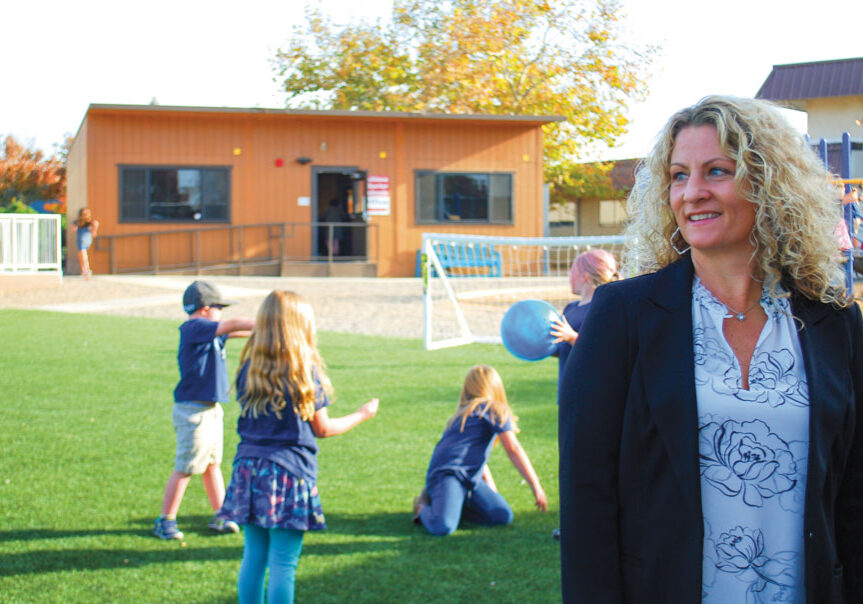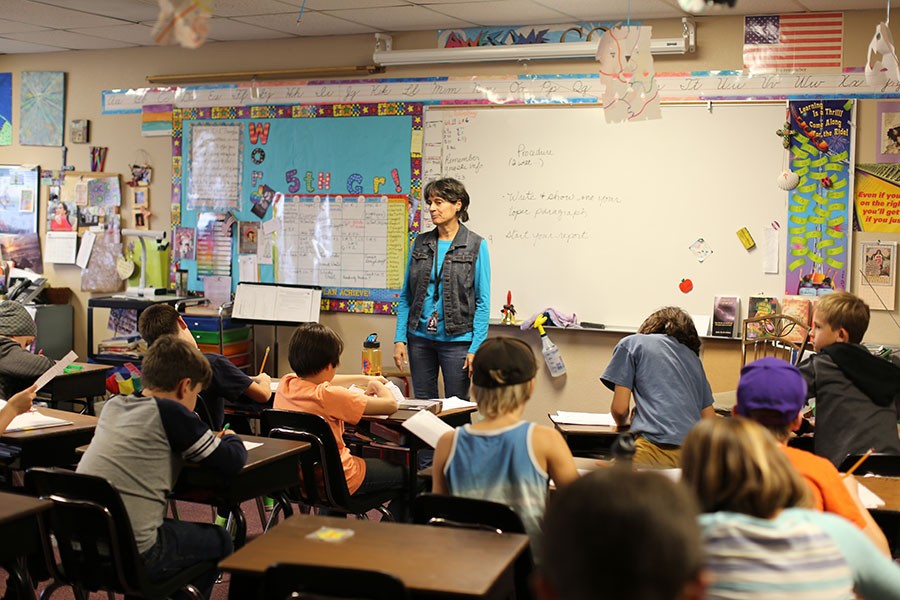 This spring, North State students will have to bring some computer savvy along with a sharpened pencil to school on test day, when millions of California’s kids sit down for the first Smarter Balanced Assessments that will provide a glimpse of how implementation of the Common Core State Standards is faring in the classrooms.
This spring, North State students will have to bring some computer savvy along with a sharpened pencil to school on test day, when millions of California’s kids sit down for the first Smarter Balanced Assessments that will provide a glimpse of how implementation of the Common Core State Standards is faring in the classrooms.
Students took field tests in math and language arts last year in an assessment “dress rehearsal.” Those tests yielded no data, but they offered kids an opportunity to practice using computers to answer questions aligned to the new Common Core standards for math and for English language arts and literacy.
Local educators say they have worked hard to implement the new standards since California adopted them in 2010, and this year’s tests will generate actual student performance data for the first time. “We’re pretty anxious to get results. We want to know how we are doing,” says Mike Freeman, superintendent of Grant Elementary School in Redding.
The Common Core State Standards specify what students should learn at each grade level and aim to increase instructional consistency from state to state. By 2011, 45 states, including California, had adopted the standards, spurred in part by a deadline to apply for federal funds through the Race to the Top initiative. But the standards have proven controversial, polarizing education public policy discussions across the country.
The biggest changes for California’s kids lie in the assessments, says Brian Ausland, director of educational research at Chico-based Navigation North Learning Solutions, a national education consulting firm that conducted early research for the Smarter Balanced Assessments. “The exams mark a big transition for the state, not only because they move students away from paper-and-pencil tests to digital tests but also because they are adaptive,” Ausland says.
That means that test questions can differ among students depending on how they respond to the questions. When students demonstrate mastery of a concept by answering a series of questions correctly, the test moves on to questions about another topic. However, if a student answers a question incorrectly, the test will generate follow-up questions to give students another chance or to zero in on gaps in student learning, Ausland explains.
New Focus On Critical Thinking, Collaboration And Communication
Proponents maintain that with proper teacher training and some patience, the Common Core will better help students succeed in the long run both in their studies and in the workplace because of the Core’s new emphasis on critical thinking, collaboration and communication.
“When you really look at Common Core and the way it’s being taught, it’s just good teaching,” says John Durfee, 8th grade math and science teacher at Berrendos Middle School in Red Bluff. “It’s more interactive, more student-driven instruction. It encourages learning for the sake of learning and getting at actual knowledge – the deeper understanding of the conceptual part of a lesson.” Good teachers have been teaching this way for years – teaching critical thinking and alternative ways to find an answer, he adds.
Parent Christelle Bellingan, whose two children attend University Preparatory School in Redding, moved to the North State six years ago from South Africa where she says teachers reviewed concepts continuously and introduced lessons progressively to build deeper understanding. She welcomed the Common Core changes as a step in the right direction. “When you are rushing through and it’s only rote learning, the students don’t get as much out of it. In South Africa, the math was more like Common Core,” Bellingan says.
“It has been a big transition,” says Christelle’s son Sam Bellingan, a sophomore who is taking an honors math class. “I think the new program offers a lot of opportunity for review,” he says. In math, he notes, classes no longer focus on teaching algebra one year and then geometry the next but rather present math in a more integrated and methodical way. And while he can’t wait to get to calculus, he notes that the Core-aligned instruction appears to allow students – those being exposed to a new concept as well as those reviewing a concept – to build their skills one building block at a time.
No Common Ground On The Common Core
But some parents say they are frustrated with the changes, in part because they aren’t familiar with the new methodologies being used to teach their children so they can’t help out with homework. Area schools have hosted parent workshops to educate parents; in some classrooms, teachers even assign homework that specifically requires students to “teach your parents” in order to receive credit.
Other parents oppose Common Core more on principle, saying that it represents another and possibly graver shift away from the child-and-parent relationship. “For me the whole change signifies more and more government control,” says Nurina Tonkin, a Redding mother of four. While her older two children attend public high school, she now homeschools her younger two because she prefers using curriculum that isn’t necessarily tied to the Common Core and because she prefers that her children not take the Common Core-aligned assessments. “It’s important for parents to become aware of the changes in their children’s classrooms and not just accept that it’s a change for the better,” says Tonkin.
Assessing Students At The Computer
Local administrators suggest that as with past education reforms, implementation of Common Core also will take time. School districts are investing in workshops to train teachers and on-site administrators to improve student Core mastery and effective test preparation. The Siskiyou Office of Education, for instance, offered more than a dozen training sessions last year for teachers and principals. Schools will continue to offer workshops for parents to discuss how they can support their children at home, and how they can help kids prepare for the upcoming assessments.
“These standards are more challenging, but we are working to help these students to get the skills they need to succeed in the future,” says Martie Hagarty, assistant superintendent of the Siskiyou Office of Education. “As parents and as teachers, we want our students to be able to solve problems on their own, to think critically and also to communicate and interact with others,” she says. “We want them to be creative and to collaborate. Learning is not just about multiple choice tests.”
Local educators add that students are not only developing their academic skills in preparing for test day, but also their computer savvy. Students are given class time to practice keyboarding and to familiarize themselves with tablets and computers.
“We’re asking kids now to come in and compose at the computer,” says Freeman, who notes that Grant’s website also lists keyboarding resources to support additional practice at home. “It’s one thing to ask students to show what they know. It’s another to ask students to show what they know on a computer.” Still, Freeman says he welcomes the changes Common Core has brought because the new standards challenge students to take their learning to a deeper level.
Yet some parents remain wary of the new assessment, expressing concern that it’s not standardized if it generates different questions for every student. Others remain concerned that there is simply too much data being collected, with some families even electing to opt out of the testing.
Tonkin notes that many parents, including homeschoolers, are so closely involved in their children’s education that they already know their children’s strengths and weaknesses without having to rely on test results. And she says long-range data tracking runs the risk of student profiling or pigeonholing that would lead some students to be encouraged to pursue math, for instance, while others are tagged as “low performers” before they even have an opportunity to engage with the material being taught.
“Testing doesn’t give a great finality on how your child’s doing. Some kids just don’t test well, but they do well in other forums or develop later in life. So I don’t think testing, especially at the elementary level, is beneficial,” says Tonkin.
Educators say that the data being collected is performance data that will allow teachers to more clearly understand current gaps and more effectively adapt to students’ needs. As an example, Durfee says he appreciated the results of a recent benchmark assessment at Berrendos that flagged a concept – rational and irrational numbers – that needed to be reviewed because only 14 percent of the students taking the test answered related questions correctly. That data prompted teachers to re-teach the lesson.
“It’s data that will help us help children become better students and to be more successful at the next level. It’s very specific data to tell us where the gaps in a student’s learning are. It allows you to know whether the student really knows the curriculum or if they’re just getting lucky and guessing,” Durfee says.
“Kids know a lot more than what multiple choice tests show,” says Durfee. “Once they learn how to use the technology, it’s amazing what kids can do.”
Comment Policy: All viewpoints are welcome, but comments should remain relevant. Personal attacks, profanity, and aggressive behavior are not allowed. No spam, advertising, or promoting of products/services. Please, only use your real name and limit the amount of links submitted in your comment.
You Might Also Like...

The Bond Between Grandparents and Grandchildren
Grandparents Day is September 9th, but smart parents regularly celebrate the vital role that grandparents play in their family’s life every day. The strong bond between grandparents and their grandchildren […]

Cedar Grove School: A Place Where Children Can Blossom
“Humans learn most easily and naturally in a holistic way,” Cate Clother, founder and director of Cedar Grove School, a Waldorf-inspired multicultural heritage school, says. Waldorf curriculum is built around […]
Mi Escuelita Maya Preschool & Children’s Performing Arts Program – A Place of Learning and Inspiration
In a setting best described as welcoming and warm, where diversity is honored and creativity abounds, children go about the business of learning with great enthusiasm. Smiling teachers clearly are […]

Achieve Charter School: New Beginnings
Up from the Ashes In August 2019, just 10 months after the Camp Fire leveled Paradise, CA, 217 kindergarten-through-8th-grade students streamed onto Achieve Charter School’s newly-constructed campus in Chico, CA. […]




